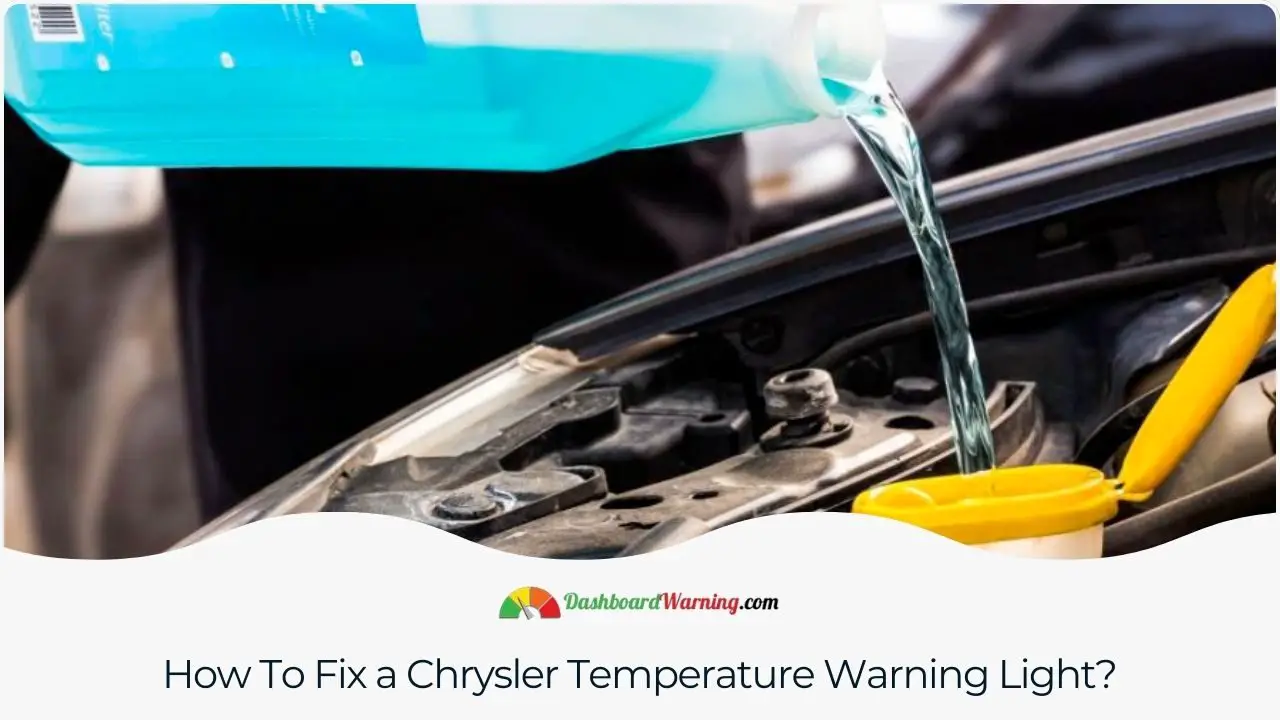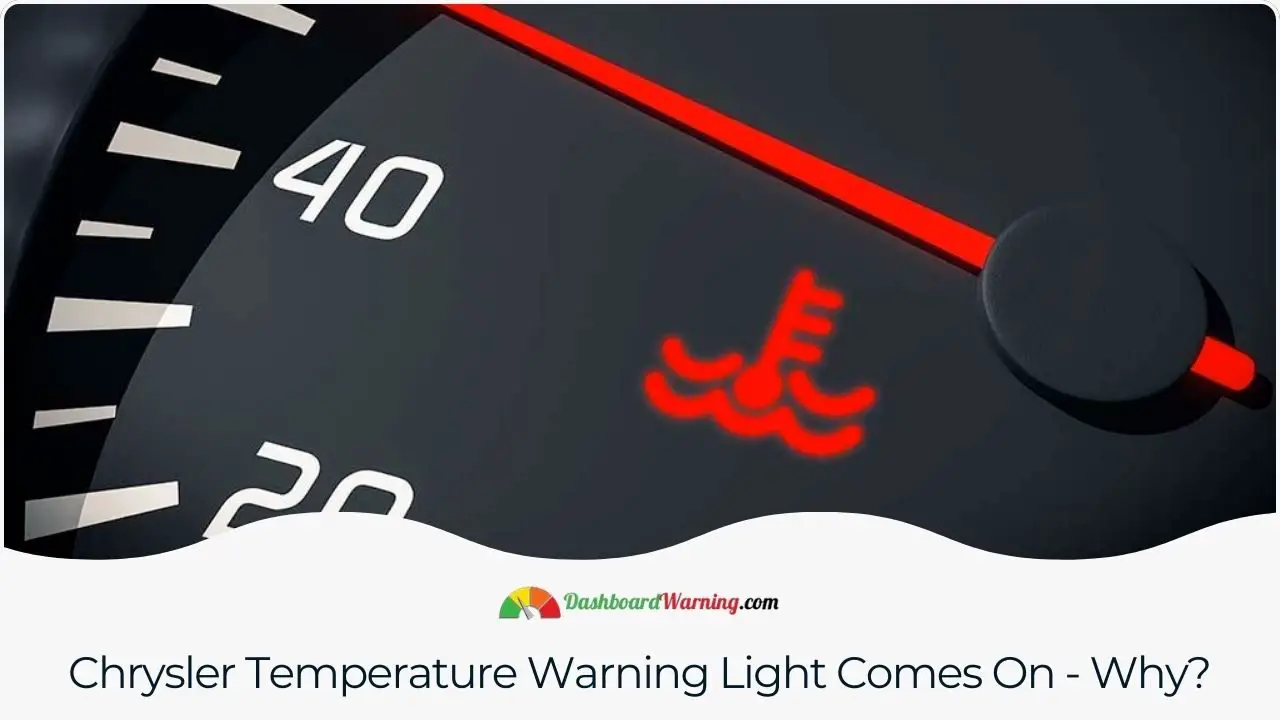The Chrysler Temperature Warning Light is one of the vehicles' most common warning lights. It indicates a problem with the engine or transmission and should be checked as soon as possible. If left unchecked, this light can lead to costly repairs. This article will discuss what the Chrysler Temperature Warning Light means and how to deal with it. We will also provide some tips on how to check the condition of your vehicle’s engine and transmission. Finally, we will offer some preventive measures you can take to avoid this warning light from appearing in the first place.
🚨You may be interested in: Chrysler Esp Bas Warning Light
What is a Chrysler Temperature Warning Light?

The engine in your vehicle, a complex mechanism, relies on various processes to propel your car. The engine generates significant heat during combustion, which must be managed to stop it from getting too hot.
The vehicle's cooling system plays a crucial role in preventing engine overheating. It circulates coolant, which absorbs and then disperses heat from vital engine components. A malfunction in this system puts the engine at risk of overheating.
It's a critical signal when you notice the engine temperature warning light illuminated. This light means the coolant temperature is higher than normal, suggesting your engine might be overheating.
So, the Chrysler Temperature Warning Light is a warning light in the instrument cluster when the car's temperature reaches a certain level. The warning light will stay on until the car's temperature drops below a certain level, at which point it will turn off.
🚀Recommended article: Chrysler Gas Cap Warning Light
How To Fix a Chrysler Temperature Warning Light?

If you see a Chrysler Temperature Warning Light, the engine is overheating. Pull over to a safe location and turn off the engine. Let the engine cool down for at least 20 minutes before checking the coolant level. If the coolant level is low, add coolant until it reaches the full line. Do not add water to the coolant; use only a 50/50 mix of antifreeze and water. Once the coolant is filled, let the engine idle for several minutes. The temperature warning light should go off once the engine has warmed up. If the light does not go off or the engine starts to overheat again, have your vehicle towed to a nearby service station for repairs.
🚨You may be interested in: Chrysler Traction Control (Tc) Warning Light
In Summary
If you have a Chrysler temperature warning light, it is important to take the necessary steps to fix it as soon as possible. The first step is to check the coolant level and add coolant if needed. If the coolant level is fine, the next step is to check the radiator hoses for leaks. If there are any leaks, they will need to be repaired. Finally, if neither of these solutions fixes the problem, you must take your car to a mechanic for further diagnosis and repair.
🎯Suggested article: Chrysler Electronic Throttle Control Warning Light
FAQs About Chrysler Temperature Warning Light
Can I drive my car with the temperature light on?
It is not recommended to drive your car with the temperature light on, as this indicates an issue with your car's cooling system. This could be a sign of a serious problem, such as a leak in the radiator, and driving with the temperature light on could cause further damage to your car. If you see the temperature light come on, you should pull over and turn off your engine immediately to avoid any further damage. You should then call a tow truck or roadside assistance to have your car towed to a nearby mechanical workshop for repairs.
When should I worry about my temperature gauge?
If your car's temperature gauge is reading higher than normal, it is important to notice and take action. If the needle is in the red zone or close to it, this indicates that your engine is overheating, and you should pull over as soon as possible to avoid damaging your engine.
There are a few things you can do if your car starts to overheat:
Turn on the heater: This might sound counterintuitive, but running the heater will help draw heat away from the engine.
Turn off the air conditioner: Again, this will help reduce the load on the engine.
Turn on the fans: If your car has an external cooling fan, turn it on. This will help move hot air away from the engine.
Pull over and turn off the engine: Once you have taken all of these steps, if your car's temperature gauge is still in the red zone, it is time to pull over and turn off the engine. Letting your car idle in this situation can cause serious damage to your engine, so it is best to err on the side of caution and turn it off until it has cooled down completely.
How long can you drive with the temperature light on?
The temperature light is an indication that the engine is overheating. If the light is on, you should pull over and turn off the engine as soon as possible. Continuing to drive with the temperature light on can damage the engine.
What might cause the temperature warning light to come on?
When the engine temperature warning light, which looks like a thermometer or reads "TEMP," illuminates, the vehicle's engine has exceeded its recommended maximum temperature. This situation should be addressed immediately, as an overheated engine can result in major damage that may not be repairable. Taking swift action is paramount to avoid further costly damage to the vehicle.
What should you do if the temperature warning light goes on?
If the temperature light goes on or the gauge enters the red zone, it is paramount to pull off the road immediately and stop safely away from traffic. Stopping the engine is also essential to prevent further damage. Doing so will help avoid costly repairs and ensure safety for those in the vehicle.
Why is my temperature light on, but my car is not overheating?
If an individual is experiencing problems with the engine temperature light coming on, but their vehicle is not overheating, the likely cause is a faulty sensor. Sensors are used to monitor engine coolant continuously, and when they malfunction, it can lead to false readings of engine temperatures, which could trigger the warning light. Individuals need to have any issues regarding sensors checked by a professional to ensure the proper performance of their vehicle.
Was this page helpful?


More important content about Chrysler
Chrysler Pacifica Auto Start Stop Warning Light
Chrysler Pacifica Dashboard Warning Lights and Meanings
2021 Chrysler Pacifica Dashboard Symbols
Chrysler Esp Bas Warning Light
Chrysler Gas Cap Warning Light
Tips and Advice
Porsche Cayenne Years To Avoid
Subaru Legacy Years To Avoid - 5 Worst Years
Pt Cruiser Years To Avoid
Use 5w30 instead of 0w20 - Advantages and Disadvantages
Tractor Dashboard Symbols And Meanings
Suzuki Sx4 Years To Avoid - 5 Worst Years